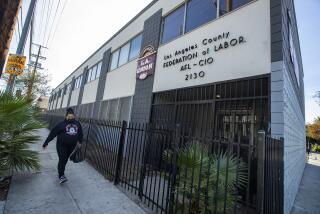Bada Bing, L.A. City Hall Has a RICO Ring
- Share via
In two stunning rulings last week, a federal judge said that when the Los Angeles Police Department behaves like the mob, it can be sued as though it is the mob. And like mob kingpins, the mayor, the city attorney and council members can be taken down with the police.
Judge Gary Allen Feess, who presides over all Rampart scandal cases and the consent decree, held that, under the federal anti-racketeering law, Rampart victims may hold City Attorney James K. Hahn, Mayor Richard Riordan and past and current city council members liable for LAPD corruption and brutality. The rulings could cost the city hundreds of millions of dollars and expose Hahn, Riordan and the council members personally; the Racketeer Influenced and Corrupt Organizations law, known as RICO, provides for tripling of damages awarded by a jury.
Ironically, just before the rulings were made public, Riordan said that “the best way to stop police corruption in its tracks is to punish the command staff, because they should know who the bad apples are and if they don’t, they should be fired for that.” For eight years, Hahn, Riordan, and the City Council members all knew who the bad apples were, but were in public denial.
In the racketeering ruling, Feess tossed aside the city’s argument that it would be unfair to permit victims of the LAPD to use the federal anti-mob law, because the law was meant to be used against organized crime. Feess ruled that the LAPD, as well as its facilitators in city government, fit the criteria for organized crime. Those criteria include conduct of an enterprise through a pattern of racketeering activity. A pattern of racketeering activity is at least two acts within a 10-year period indictable as obstruction of justice, tampering with witnesses, fraud or attempted murder.
With more than 110 overturned Rampart convictions because of obstruction of justice, witness tampering and attempted murders, 135 Rampart civil cases pending and 250 more Rampart cases in the pipeline--and more than 300 civil jury verdicts against LAPD officers over just the past 10 years--proving a RICO case will not be difficult.
With the LAPD, its chief and its civilian bosses and lawyers now exposed to racketeering charges, it remains to be seen what will happen. For many years, the party line has been for both the LAPD and the city’s politicos to tough it out, no matter how bad it got. So far, they have succeeded. Reform was called for in the July 1991 Christopher Commission Report. Healing was called for after the April 1992 riots. During the ensuing decade, no elected official with power over the LAPD took any significant action to address the reasons the reforms were called for.
If city officials have learned anything from years of defending bad cops or from Feess’ rulings, not only will police abuse victims be compensated, but the LAPD’s 50-year reign of terror, which victimized the population and cost taxpayers hundreds of millions of dollars, will end.
More to Read
Sign up for Essential California
The most important California stories and recommendations in your inbox every morning.
You may occasionally receive promotional content from the Los Angeles Times.










